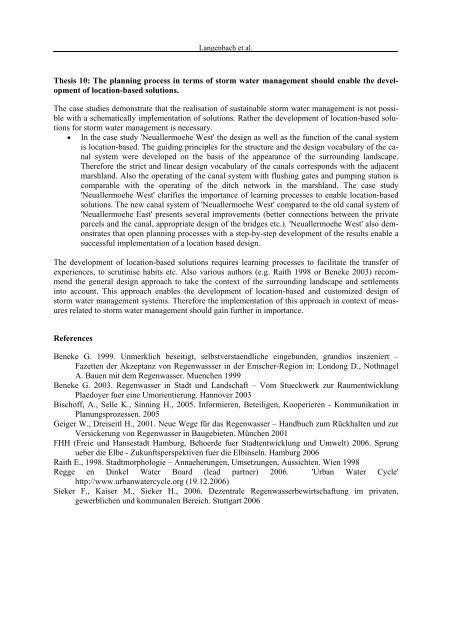Theses for the Future of Water Sensitive Urban Design (WSUD)
Theses for the Future of Water Sensitive Urban Design (WSUD)
Theses for the Future of Water Sensitive Urban Design (WSUD)
You also want an ePaper? Increase the reach of your titles
YUMPU automatically turns print PDFs into web optimized ePapers that Google loves.
Langenbach et al.<br />
Thesis 10: The planning process in terms <strong>of</strong> storm water management should enable <strong>the</strong> development<br />
<strong>of</strong> location-based solutions.<br />
The case studies demonstrate that <strong>the</strong> realisation <strong>of</strong> sustainable storm water management is not possible<br />
with a schematically implementation <strong>of</strong> solutions. Ra<strong>the</strong>r <strong>the</strong> development <strong>of</strong> location-based solutions<br />
<strong>for</strong> storm water management is necessary.<br />
• In <strong>the</strong> case study 'Neuallermoehe West' <strong>the</strong> design as well as <strong>the</strong> function <strong>of</strong> <strong>the</strong> canal system<br />
is location-based. The guiding principles <strong>for</strong> <strong>the</strong> structure and <strong>the</strong> design vocabulary <strong>of</strong> <strong>the</strong> canal<br />
system were developed on <strong>the</strong> basis <strong>of</strong> <strong>the</strong> appearance <strong>of</strong> <strong>the</strong> surrounding landscape.<br />
There<strong>for</strong>e <strong>the</strong> strict and linear design vocabulary <strong>of</strong> <strong>the</strong> canals corresponds with <strong>the</strong> adjacent<br />
marshland. Also <strong>the</strong> operating <strong>of</strong> <strong>the</strong> canal system with flushing gates and pumping station is<br />
comparable with <strong>the</strong> operating <strong>of</strong> <strong>the</strong> ditch network in <strong>the</strong> marshland. The case study<br />
'Neuallermoehe West' clarifies <strong>the</strong> importance <strong>of</strong> learning processes to enable location-based<br />
solutions. The new canal system <strong>of</strong> 'Neuallermoehe West' compared to <strong>the</strong> old canal system <strong>of</strong><br />
'Neuallermoehe East' presents several improvements (better connections between <strong>the</strong> private<br />
parcels and <strong>the</strong> canal, appropriate design <strong>of</strong> <strong>the</strong> bridges etc.). 'Neuallermoehe West' also demonstrates<br />
that open planning processes with a step-by-step development <strong>of</strong> <strong>the</strong> results enable a<br />
successful implementation <strong>of</strong> a location based design.<br />
The development <strong>of</strong> location-based solutions requires learning processes to facilitate <strong>the</strong> transfer <strong>of</strong><br />
experiences, to scrutinise habits etc. Also various authors (e.g. Raith 1998 or Beneke 2003) recommend<br />
<strong>the</strong> general design approach to take <strong>the</strong> context <strong>of</strong> <strong>the</strong> surrounding landscape and settlements<br />
into account. This approach enables <strong>the</strong> development <strong>of</strong> location-based and customized design <strong>of</strong><br />
storm water management systems. There<strong>for</strong>e <strong>the</strong> implementation <strong>of</strong> this approach in context <strong>of</strong> measures<br />
related to storm water management should gain fur<strong>the</strong>r in importance.<br />
References<br />
Beneke G. 1999. Unmerklich beseitigt, selbstverstaendliche eingebunden, grandios inszeniert –<br />
Fazetten der Akzeptanz von Regenwassser in der Emscher-Region in: Londong D., Nothnagel<br />
A. Bauen mit dem Regenwasser. Muenchen 1999<br />
Beneke G. 2003. Regenwasser in Stadt und Landschaft – Vom Stueckwerk zur Raumentwicklung<br />
Plaedoyer fuer eine Umorientierung. Hannover 2003<br />
Bisch<strong>of</strong>f, A., Selle K., Sinning H., 2005. In<strong>for</strong>mieren, Beteiligen, Kooperieren - Kommunikation in<br />
Planungsprozessen. 2005<br />
Geiger W., Dreiseitl H., 2001. Neue Wege für das Regenwasser – Handbuch zum Rückhalten und zur<br />
Versickerung von Regenwasser in Baugebieten. München 2001<br />
FHH (Freie und Hansestadt Hamburg, Behoerde fuer Stadtentwicklung und Umwelt) 2006. Sprung<br />
ueber die Elbe - Zukunftsperspektiven fuer die Elbinseln. Hamburg 2006<br />
Raith E., 1998. Stadtmorphologie – Annaeherungen, Umsetzungen, Aussichten. Wien 1998<br />
Regge en Dinkel <strong>Water</strong> Board (lead partner) 2006. '<strong>Urban</strong> <strong>Water</strong> Cycle'<br />
http://www.urbanwatercycle.org (19.12.2006)<br />
Sieker F., Kaiser M., Sieker H., 2006. Dezentrale Regenwasserbewirtschaftung im privaten,<br />
gewerblichen und kommunalen Bereich. Stuttgart 2006
















